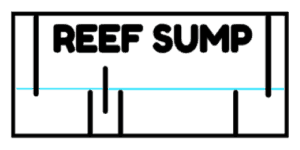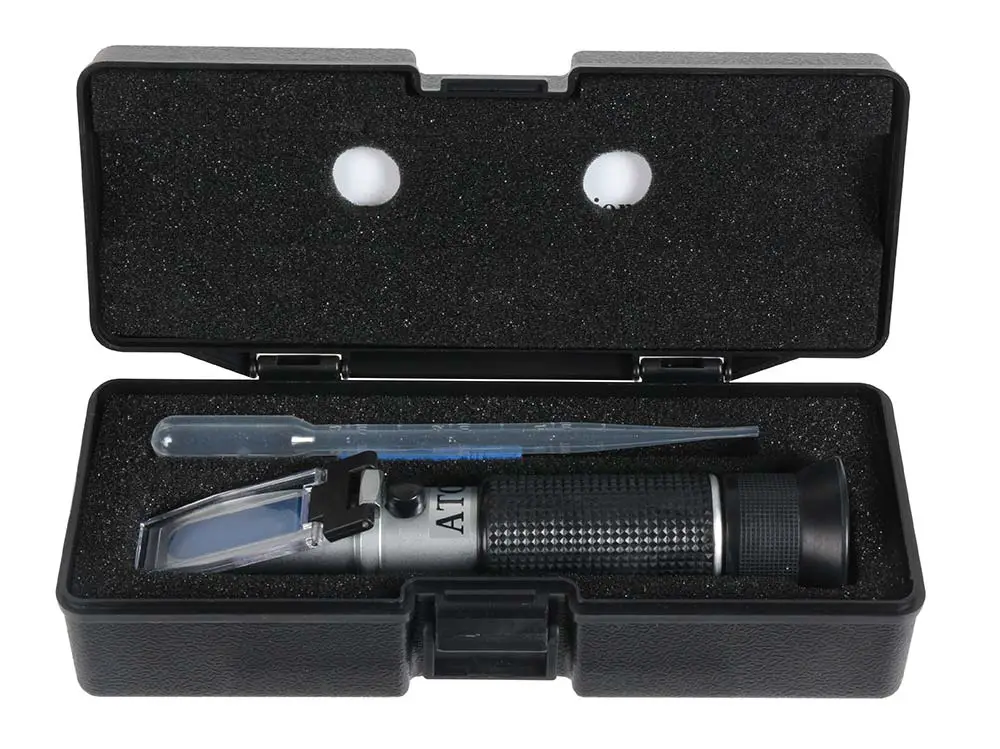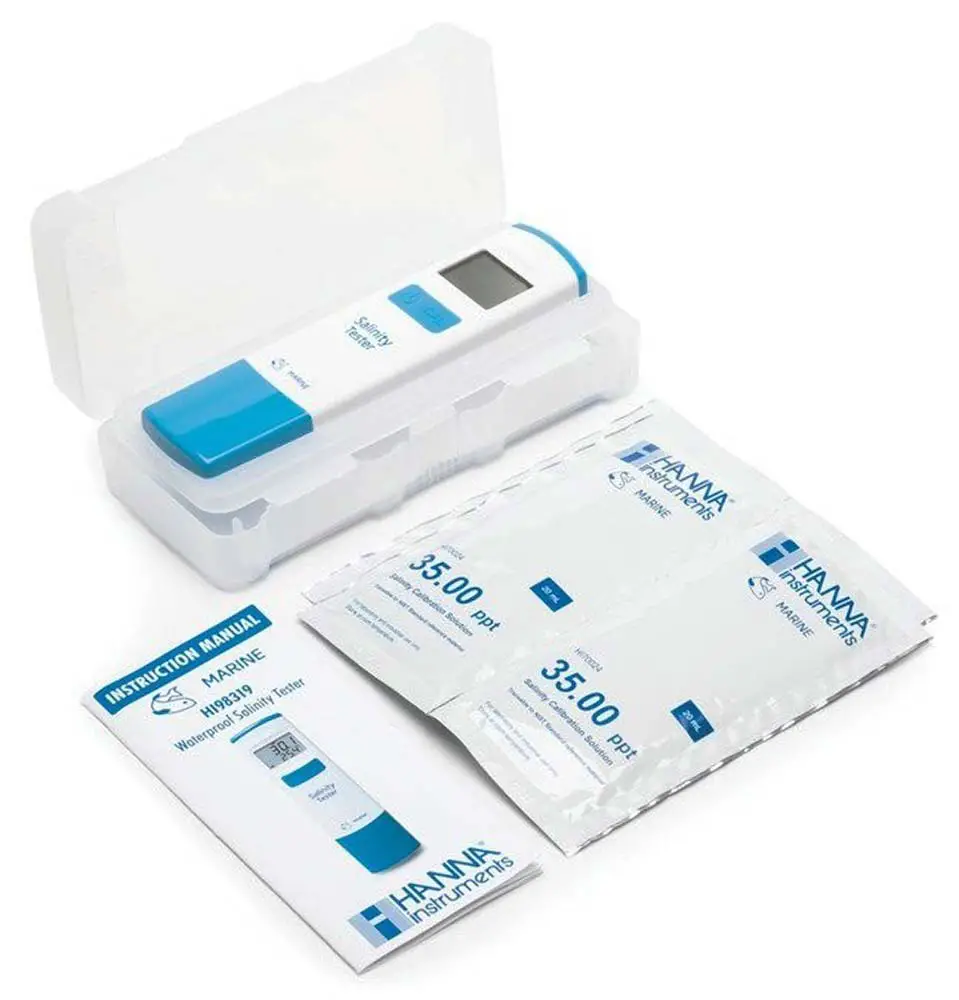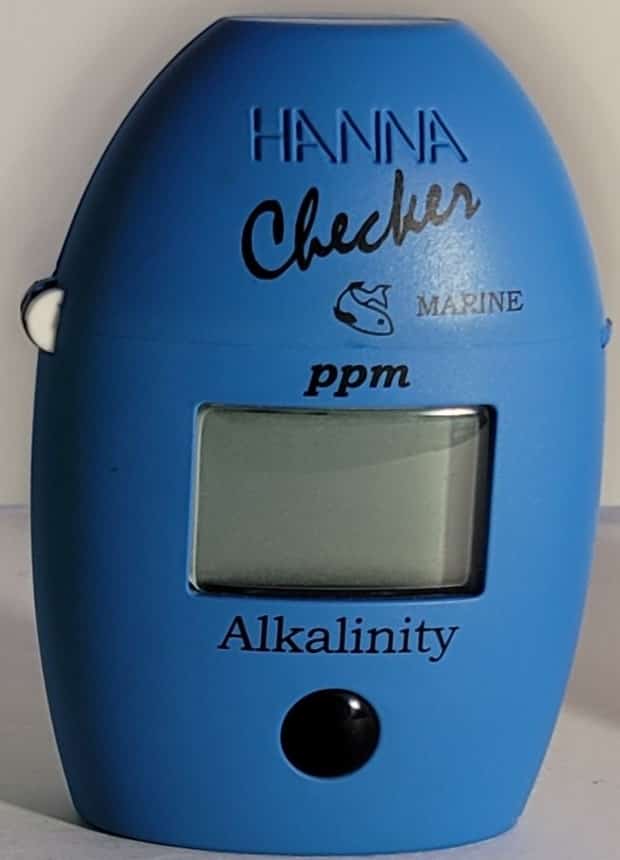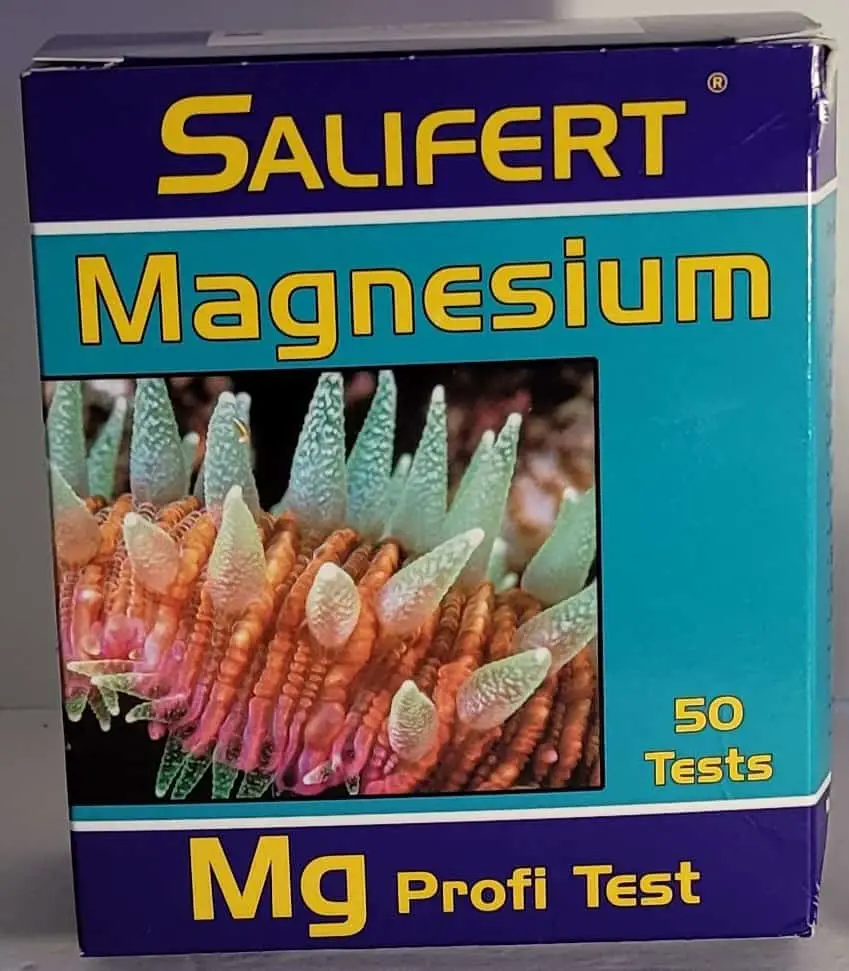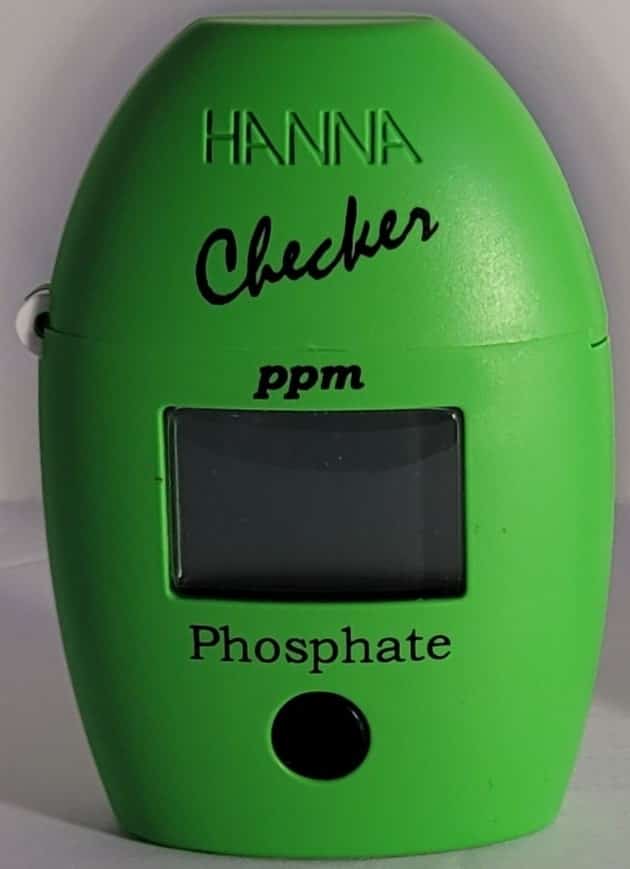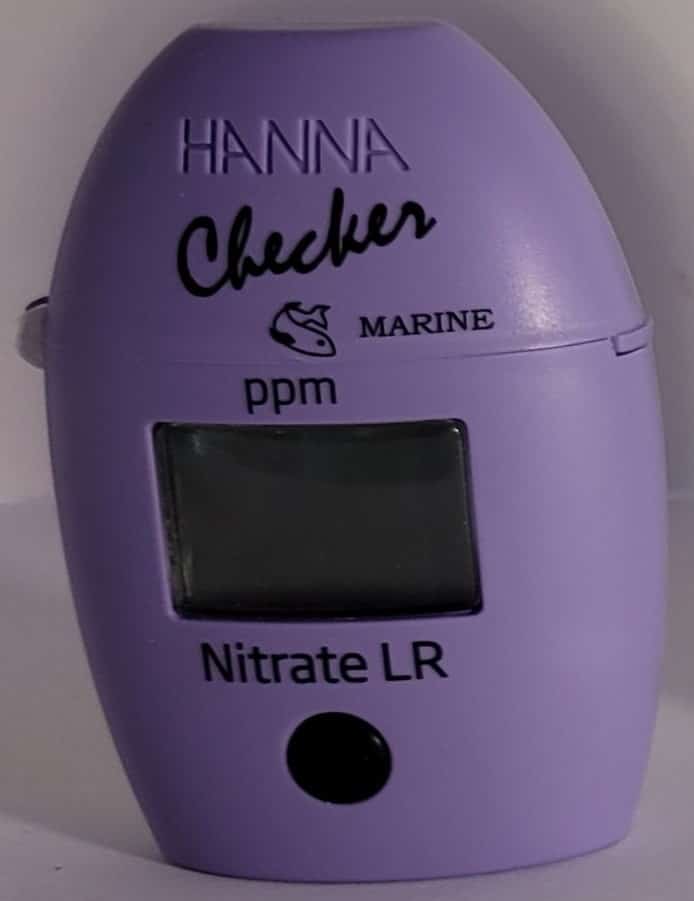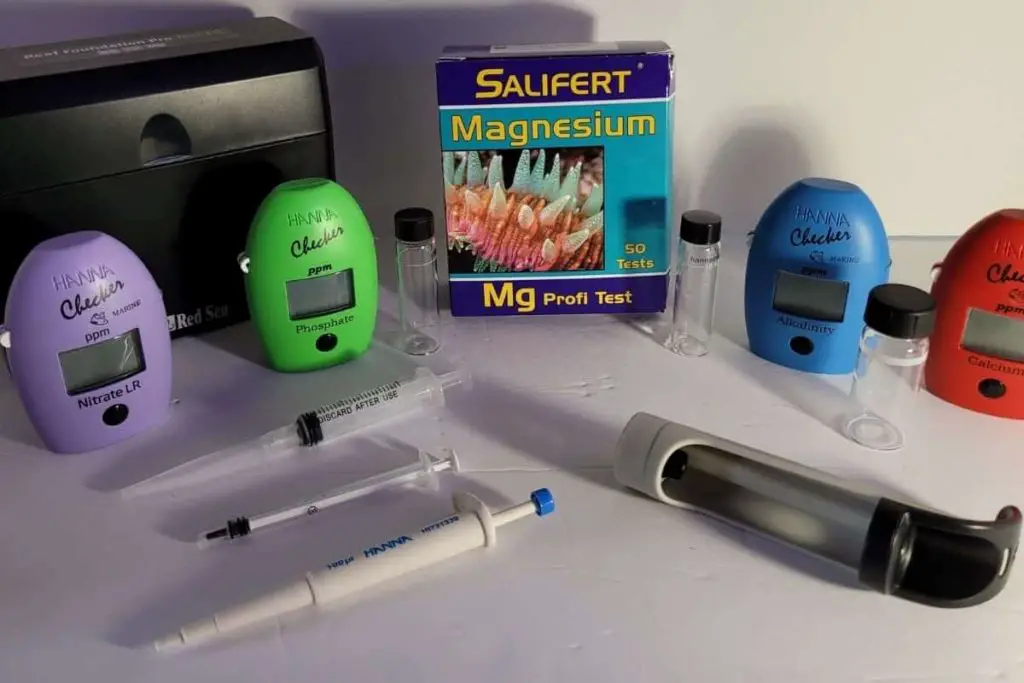
In the reef keeping hobby stability is king in having a thriving and healthy reef aquarium. Stability in reef keeping usually refers to the chemical composition and temperature of the reef tank’s water. The right elements are required to sustain live fish and corals within the tank. Good husbandry of reef tanks involves testing to establish a baseline of element parameters, adjusting to get to an ideal range, and working to maintain an ideal range of parameters through maintenance, water changes, and dosing as needed. Failure to keep parameters in acceptable ranges will lead to issues like algae taking over and poor health and even death of livestock. It’s a good idea to know the different elements involved in reef tank water parameters, how to test for them, and how to manage their levels.
Many elements make up the chemistry water parameters of reef aquariums. Read on to learn more about the most key elements in the water parameters of a reef aquarium. The guide will go over individual elements and will include how to test, how often to test, how to adjust, and how to keep the element stable in your reef tank. The guide below gives recommendations for a mixed coral and fish reef tank. Parameters can vary depending on livestock and type of tanks such as fish only and brackish tanks.
Salinity
What is the water parameter salinity in a reef aquarium?
Salinity is a measurement of the amount of salt within your reef aquarium water. Once the salt has been dissolved into freshwater it can be measured in units of specific gravity or parts per thousand. Saltwater fish have adapted their bodies to live in saltwater only and salinity is a crucial element to keep stable.
What level should salinity be in a reef aquarium?
Salinity should be 1.023 – 1.026 SG or 32-35 ppt.
How do you test for salinity in a reef tank?
There are several ways to test for salinity in a reef tank. The beginner’s way to measure salinity is the use of a hydrometer. Hydrometers work by filling it up with saltwater and reading the measurement where a floating arm within the hydrometer points at. These suffice for beginners, but readings are not always accurate. Air bubbles or salt/mineral deposits within the hydrometer can cause inaccurate readings.
The most common way that reefers measure salinity is with the use of a refractometer. Refractometers work by adding a few drops of the tank’s water onto it, holding it up to the light, and looking through an eyepiece to get an accurate reading of salinity. I used refractometers for years and found them to be accurate and easy to use.
Eventually, with multiple, tanks I graduated to the use of a digital salinity tester. The model I currently use is the HI98319 Hanna Salinity and Temperature Tester. The Hanna tester like many other digital testers utilizes electrical current to give an accurate reading of salinity. The Hanna tester takes it a step further and adjusts salinity based on temperature. It is very nice to simply dip the tester in water and get an exact digital reading of salinity.
How often should you test for salinity in a reef tank?
Salinity is a very important component of a healthy reef tank and should be regularly checked at least weekly. I check the salinity in my tanks each time I do a water change or regular maintenance. It’s also important to check salinity if you have any unexpected water level changes. These unexpected events usually involve the malfunctioning of an auto top-off system when it either fails to work and water levels go down resulting in high salinity, or the system stays on dumping fresh water into the system resulting in low salinity. When this happens it’s important to get the tank’s salinity back in range.
How do you adjust salinity in a reef tank?
To adjust salinity in a reef tank it’s best to do it gradually via water changes. It’s usually never a good idea to add salt directly into your reef tank. To adjust salinity in your reef tank pre-mix salt and fresh water to a higher or lower salinity based on if you are trying to raise or lower salinity in your tank. Let it mix up for a few hours and come up to temperature. Then remove water from the tank and replenish with the newly mixed saltwater.
How do you keep salinity stable in a reef tank?
To keep salinity stable in a reef tank you must keep the overall water level of the tank stable. Water in a reef tank will evaporate over time, and as it does so the salt is left behind making the salinity in the tank rise. To keep the level stable you must add fresh water to the system periodically. If you are using a sump there is usually a line in the sump that will show you the system’s preferred water level, you add water to keep the water level equal to the line. If you are not using a sump, the level would be at the top of the display tank.
The easiest and best way to maintain the water level in reef tanks and salinity is through the use of an auto top-off system (ATO). ATOs work by sensing the level of water in the tank, kicking on a pump in a freshwater reservoir when low, and turning off the pump when the water level is back to normal. There are different kinds of ATOs available on the market that use float switches, optical sensors, and thermal sensors to measure the level of the water. On my tanks, I’ve always used float switches with great success.
What ReefSumper does for Salinity in his reef tanks
Aim for 1.025 SG
Measure weekly during maintenance water changes
Utilize Hanna Salinity tester to test
Utilize ATO on all tanks to keep salinity stable
Recommended salinity equipment from Amazon
Hanna Digital Salinity and Temperatur Tester
Temperature
What is the water parameter temperature in a reef aquarium?
The water parameter temperature in a reef aquarium is the measurement of how hot or cold the water in the tank is. Temperature is measured in degrees Fahrenheit or degrees celsius.
What should the temperature be in a reef aquarium?
The temperature in a reef aquarium should be 76 – 80 degrees Fahrenheit and must be kept stable.
How do you test for temperature in a reef tank?
Testing temperature in a tank usually requires a probe within the tank to measure the temperature which is then displayed on a unit outside of the tank. One way that this can be done is with the use of a heater controller like the WiFi Aquarium Heater Controller by Ink Bird. Probes sit inside the tank water and connect to the controller. The controller has outlets that allow you to plug in your tank heaters. The Ink Bird controller can be set to a specific temperature and will cut the power off and on to the heaters based on the temperature readings.
Some heaters are digital themselves and will show the current tank temperature on the heater themselves. The cobalt Neo-therm heater is one that I’ve used in the past that shows the tank’s temperature on it. There are also stickers that you can apply to the outside of the tank that shows the temperature. Use these with caution as they can give off inaccurate readings based on where they are placed and the thickness of your tank’s glass.
The method that I like to use with reef tanks is temperature monitoring through an Apex controller. The Apex uses a temperature probe and can control your heaters similar to the Ink Bird Controller. It is very nice to have real-time temperature reading and notifications sent to your phone when ranges get out whack.
How often should you test temperature in a reef tank?
The temperature in a reef tank should be continuously tested and monitored. Out-of-range temperature either high or low is a common reason for completely killing a reef tank quickly. When the temperature gets out of range you’ll want to know about it as quickly as possible so that you can step in and correct it.
How do you adjust the temperature in a reef tank?
To adjust the temperature in a reef you either increase heat in the tank or cool off the water. Increasing the temperature in a reef tank can be as simple as increasing the temperature on your heater. It’s important to size your heater for the amount of water volume in your system. A general rule of thumb is 1 watt per gallon, but this can vary depending on where your tank is and what temperatures it is exposed to. You may need to add additional heaters if you have a very large system.
How do you keep temperature stable in a reef tank?
To keep temperature stable in a reef tank have a heater that is sufficient for the water volume in your tank, monitor the temperature at all times, and adjust as necessary. One of the most common issues for tank meltdown is a malfunctioning heater. Usually, this is the result of a heater getting stuck in the on position resulting in the tank overheating and the death of fish and corals. The fix for this is to use a controller that turns on and off power to a heater based on the current tank temperature. The use of an Apex or Ink Bird is a must for my tanks and temperature management.
What ReefSumper does for Salinity in his reef tanks
Maintain temperature close to 78 Fahrenheit
Utilize Apex to monitor, control heaters, and notify
Recommended temperature equipment on Amazon
Inkbird ITC-306A WiFi Temperature Controller
Eheim Jager TruTemp Submersible Aquarium Heater
PH
What is the water parameter PH in a reef aquarium?
In a reef, aquarium PH is how acidic or alkaline the water is. PH is measured on a scale of 1-14 with 7 being the neutral level, less than 7 being acidic, and levels greater than 7 being alkaline. The ideal PH for a reef tank is between 8.1 and 8.3 and most salt will mix close to this range when freshly made. Over time PH can drift lower as waste and carbon dioxide respiration from fish happens in the tank. High PH can lead to precipitation of calcium carbonate which can clog equipment and low PH can cause coral demise stress on fish.
What level should the PH be in a reef aquarium?
The ideal level of PH in a reef tank is between 8.1 and 8.3 with the acceptable range being 7.8 to 8.4.
How do you test for PH in a reef tank?
The two main ways to test for PH in a reef tank are with test kits and with PH meters. With a test kit dyes are utilized that change colors based on the PH of the water being tested. Once the dye has changed color it can be compared to a visual scale to determine the PH level. With a handheld meter, the meter is placed into the water and gives a digital readout of the PH level. There are other devices such as the Neptune Apex prob which connects to the Apex controller and provides a constant PH reading.
How often should you test for PH in a reef tank?
If regular maintenance and water changes are happening with your reef tank constantly checking PH is often unnecessary. I keep a strict maintenance schedule including weekly water changes on my tanks and tend to test PH only about once every 3 months more out of curiosity. It can be important to test PH when other variables that impact PH are introduced to the tank such as the addition of additives with high PH such as kalkwasser. Increasing PH to out-of-range levels can lead to problems like precipitation of calcium carbonate that can build up on equipment leading to failure. Other things like high levels of carbon dioxide in the room where the tank is can lead to lower PH in the tank. Getting fresh air in the room, running a fresh air line to your skimmer, and adding a high PH additive like kalkwasser can help.
How do you adjust PH in a reef tank?
To raise PH products like soda ash can be added to the tank to increase levels. To lower PH vinegar, lemon juice, and other chemical products can be used to lower PH.
How do you keep PH stable in a reef tank?
The easiest way to keep PH stable in a reef tank is through regular maintenance and water changes. With higher demand tanks full of coral you will need to maintain the buffers available to coral growth by adding them into the tank. This can be accomplished by dosing the tank with calcium, magnesium, and soda ash. A calcium reactor can also be used to control PH.
Recommended PH products from Amazon
ORP
What is the water parameter ORP in a reef aquarium?
ORP is the oxidation-reduction potential of the water in a reef aquarium. ORP is measured in millivolts (mV). ORP is complicated and filled with unknowns when considering reef tanks. At a basic level, it is a measurement of the balance between oxidizers and reducers in the water. There are ways to try to control ORP manually, but it is an unproven theory that is probably not worth attempting in a reef tank unless you are very experienced or want to push the current state of best practice in reefing. I would recommend not trying to manually control ORP and if you do monitor it you can think of it like a pulse of the reef tank that may let you know of a significant change in your tank, like the die of a large fish or coral.
What level should the ORP be in a reef aquarium?
ORP can be very variable with 250-400 mV being a good range for reef tanks.
How do you test for ORP in a reef tank?
Measuring ORP is done using a probe and meter. A common way to measure ORP in the hobby is to use an Apex controller with an ORP probe. This method will give you a constant reading of ORP can give you alerts if ORP goes outside of a desirable range. Other ways to measure are with the use of ORP meters that you dip into water for measurements.
How often should you test for ORP in a reef tank?
If you are going to test for ORP in your reef tank my recommendation would be to measure it constantly to establish a baseline and ability to respond to emergent situations quickly if readings go out of range.
How do you adjust ORP in a reef tank?
Generally to keep ORP in check regular maintenance will accomplish this. Also if anything dies within your tank it is best to remove it quickly as the decaying matter can cause ORP to drop. The other unproven method is to use an ozone reactor to inject ozone directly into the tank water. I do not recommend this as it is an unproven method of reef keeping with a degree of risk in using it. An ORP controller and carbon where gas exits (reactor intake/outtake protein skimmer intake/out take) is necessary.
How do you keep ORP stable in a reef tank?
Regular maintenance and removal of any dead or decaying matter is the best way to keep ORP stable in a reef tank.
Recommended ORP products from Amazon
Hanna Instruments HI 98121 Combination pH/ORP/Temperature Tester
Calcium
What is the water parameter calcium in a reef aquarium?
Calcium is one of the most important parameters in the reef aquarium. Calcium is utilized by both corals and fish is necessary for growth and health. Calcium allows for fish and corals to calcify their skeletal bodies and grow. A lack of available calcium in the reef tank will stunt growth. Calcium is measured in parts-per-million in the reef hobby.
What level should the calcium be in a reef aquarium?
The ideal range for calcium in the reef aquarium is 380-480 with natural ocean water being around 420.
How do you test for calcium in a reef tank?
Calcium can be tested using testing kits with a colored dye that changes color and is compared to a color chart to give out a reading. There are also handheld digital testers that give an exact calcium measurement.
How often should you test for calcium in a reef tank?
Calcium should be tested every week to ensure that your livestock has the necessary calcium for growth. It is especially important to test if new large or calcium heavy consuming corals are added to the tank or if growth has been stunted.
Testing depends on the type and load of thank you have. If you have a tank with many hard stony corals, the need for calcium will increase and you will want to test weekly to allow for supplementation of calcium to maintain within range. A tank with limited corals may do well with simple water changes as most salt mixtures include calcium in the mix. The idea is to measure your baseline of calcium one day and measure again in 5 days to understand how much calcium your tank uses in 5 days. From there you can calculate how much to dose regularly. Many online calculators can help you with the dosing calculations.
How do you adjust calcium in a reef tank?
There are many ways to adjust calcium in a reef tank including dosing 2-part, utilizing kalkwasser, and incorporating a calcium reactor. The other way to adjust calcium is to do water changes. Calcium is part of most salt mixes and some salt mixes have more than others. When you change out the water you replenish some of the elements like calcium. When starting with a new tank water changes may be enough to maintain a good calcium range, but eventually, supplementation is usually needed depending on coralline algae growth and what and how corals the tank has.
How do you keep calcium stable in a reef tank?
To keep calcium stable in a reef tank conduct water changes and when necessary supplement calcium through dosing 2-part, kalkwasser, or utilizing a calcium reactor.
Recommended Calcium products from Amazon
Hanna Marine Calcium Checker HI758
Salifert Calcium (Ca) Test Kit
Alkalinity
What is the water parameter alkalinity in a reef aquarium?
Alkalinity in a reef aquarium is the buffering ability of the tank’s water once acids are introduced. This buffering ability is what helps keep PH stable and in an acceptable range. Alkalinity also plays an important role in supplying carbonate and bicarbonate to corals which are required for coral growth and health. Alkalinity is one of the most important elements to monitor on a reef tank.
What level should the alkalinity be in a reef aquarium?
Alkalinity in reef tanks should be 8-12dKY or 2.86 -4.29 meq/L with ocean values being 7 dKH and 2.5 meq/L.
How do you test for alkalinity in a reef tank?
Alkalinity can be tested using testing kits with a colored dye that changes color and is compared to a color chart to give out a reading. There are also handheld digital testers that give an exact Alkalinity measurement.
How often should you test for alkalinity in a reef tank?
Alkalinity is an important parameter to check in the reef tank and should be checked at a minimum of weekly for optimal health of your reef tank. Checking more frequently will help keep things stable and allow you to quickly adjust levels as needed. It is also important to check as new corals are added to ensure they are being supplied with enough elements to thrive.
How do you adjust alkalinity in a reef tank?
Alkalinity is adjusted through water changes. Water changes are usually not enough though once the demand for elements increases in a reef tank and supplementation is often needed. Supplementation of alkalinity is usually done through the dosing of 2-part, kalkwasser, or the use of a calcium reactor. For larger changes to alkalinity in a shorter amount of time baking soda or soda ash can be used.
How do you keep alkalinity stable in a reef tank?
To keep alkalinity stable you must understand the needs of the tank by testing. Once you have a baseline you can slowly start adding supplements to the tank. After you’ve added continue testing and adjusting until you can stabilize alkalinity within the desirable range. Adjustments are periodically needed depending on coral growth and additions to the tank. Dosing can be done via an automatic doser or manually using a measuring device.
Recommended Alkalinity products from Amazon
Hanna Marine Alkalinity (dKH) Checker HC – HI772
Salifert Carbonate Hardness & Alkalinity (Kh/Alk) Test Kit
Magnesium
What is the water parameter magnesium in a reef aquarium?
Magnesium in a reef tank works hand and hand with calcium and alkalinity by bonding itself to growing calcium carbonate structures and preventing precipitation. Without magnesium, it is difficult to maintain stable calcium and alkalinity levels. Magnesium is often replenished through water changes as elevated levels of magnesium are often included in high-quality salt mixes. Magnesium is measured in parts per million.
What level should the magnesium be in a reef aquarium?
Magnesium should be between 1200 – 1400 ppm with ocean values being around 1280 ppm.
How do you test for magnesium in a reef tank?
Alkalinity can be tested using testing kits with a colored dye that changes color and is compared to a color chart to give out a reading.
How often should you test for magnesium in a reef tank?
Magnesium does not get used up as much as alkalinity or calcium in the reef tank so checking every couple of weeks is usually sufficient. If you are having issues keeping calcium and alkalinity stable magnesium could be the culprit and should be checked.
How do you adjust magnesium in a reef tank?
Magnesium is adjusted in the reef tank by dosing it directly to the tank. Magnesium comes in a powder form that, should be dissolved in fresh 0 TDS water, and added to a high flow area of the tank or sump.
How do you keep magnesium stable in a reef tank?
Magnesium is kept stable in a reef tank through water changes with high-quality salt or through supplementing magnesium directly into the tank.
Recommended Magnesium products from Amazon
ESV Aquatics B-Ionic Magnesium for Coral Reef Salt Water Aquariums
Salifert Magnesium (MG) Test Kit
Phosphate (PO4)
What is the water parameter phosphate in a reef aquarium?
Phosphate (PO4) is a compound of phosphorus (P) and is naturally occurring in ree tanks and organic matter. Phosphate is measured in parts per million or ppm. Too high a level of phosphate can lead to dull and growth stunted corals. Phosphate is also a key nutrient used by algae. A high level of phosphate can lead to an outbreak of nuisance algae like green hair algae. Phosphate can enter the tank in various ways including unfiltered tap water, foods, and even some salt mixes. An item of note is that too low phosphate can also lead to dull-looking corals as well.
What level should the phosphate be in a reef aquarium?
Phosphate levels should be between 0.01 – 0.03 ppm. Natural ocean water is around 0.05 ppm.
How do you test for phosphate in a reef tank?
Testing for phosphate can be done with test kits, digital testers, and send in ICP tests.
How often should you test for phosphate in a reef tank?
Phosphate should be checked weekly and more frequently if corals are dull-looking or not growing. Also, test for phosphate if you have a nuisance algae problem in your tank.
How do you adjust phosphate in a reef tank?
To reduce high out of range phosphate in a reef tank exportation and prevention is usually the best way to reduce. Using a skimmer, macroalgae in a refugium, a turf scrubber, granular ferric oxide (GFO), and other methods like bio pellets are all ways that can be used to export phosphate. To prevent phosphates from being added to the tank you’ll want to utilize good clean ro/di water and high-quality foods and salt that have low phosphate quantities.
Supplementation of phosphate can be used to increase PO4 in reef tanks. In my opinion, it is best to keep phosphates low and within the specified range of 0.01 – 0.03 ppm. Sometimes if your water is very clean and your system is very efficient, phosphate may be undetectable and corals dull and unhappy. If this is the case phosphate can be supplemented.
How do you keep phosphate stable in a reef tank?
To keep phosphate levels low and stable, use export strategies like macroalgae and skimming. Also use high-quality foods, salt mixes, and clean ro/di water for top off and water changes.
Recommended Phosphate products from Amazon
Marine Phosphate Ultra Low Range Colorimeter – Checker HI774
Brightwell Aquatics NeoPhos Phosphorus Supplement for Ultra-Low Nutrient Reef Aquarium Systems
Brightwell Aquatics Phosphat-E – Phosphate Remover for Marine Fish and Reef Aquarium
Nitrate
What is the water parameter nitrate in a reef aquarium?
Nitrate is the end result of the nitrogen cycle in a reef tank. At a very basic level food is added to the tank, fish eat the food, waste is produced by the fish and any uneaten food, Ammonia is produced from the decaying waste, bacteria convert ammonia into nitrite, and finally Nitrobacterbacteria converts nitrite into nitrate. Nitrate can then be used by plants and corals. Excessive nitrate can lead to unwanted algae growth and other issues like dinoflagellates. Excessive nitrate levels can also cause dull coral coloration and very high levels can lead to coral death.
What level should the nitrate be in a reef aquarium?
Nitrate should be between 1-10 ppm with ocean values typically being less than 0.1 ppm.
How do you test for nitrate in a reef tank?
Testing for nitrate can be done with test kits, digital testers, and send in ICP tests.
How often should you test for nitrate in a reef tank?
A good practice is to check nitrate once a week, especially if you observe coral stress or unwanted algae growth.
How do you adjust nitrate in a reef tank?
Many of the functions of reef tank equipment are made to keep nitrate levels low and in check. The first method for reducing nitrate is to make sure you are not overfeeding. Next, filter socks catch uneaten food and other large solid waste particles, changing socks before the debris disintegrates prevents it from eventually turning into nitrate. Using a protein skimmer directly exports waste before it can go through the nitrogen cycle. Growing macro algae like chaeto remove nitrate by consuming it, and when you harvest macro you are directly exporting nitrate. Another way to immediately reduce nitrates is with water changes. Additionally, there are products like zeolite and aluminum oxide that can be used to reduce nitrates.
How do you keep nitrate stable in a reef tank?
To keep nitrate stable in a reef tank the best method is to have an overall stable and routine feeding and maintenance process. Fish should only be fed enough food for them to consume within a minute or less. When it comes to maintenance I do weekly water changes in the 20-30% range, grow macroalgae in a refugium, protein skim, and change my filter sock at least twice a week.
Recommended nitrate products from Amazon
Marine Phosphate Ultra Low Range Colorimeter – Checker HI774
Brightwell Aquatics NeoNitro – Liquid Nitrogen Supplement for Low Nutrient Reef Aquarium Tanks
Nitrite
What is the water parameter Nitrite in a reef aquarium?
Nitrite is another by-product of the nitrogen cycle in a reef tank. At a very basic level food is added to the tank, fish eat the food, waste is produced by the fish and any uneaten food, Ammonia is produced from the decaying waste, bacteria convert ammonia into nitrite, and finally Nitrobacterbacteria converts nitrite into nitrate.
Saltwater fish can handle some amounts of nitrite and in an established tank with a healthy bacteria level nitrite is taken care of naturally. Nitrite is more of a concern when initially setting up your reef tank and want to know where you are at in the nitrogen cycle and when it is safe to add fish.
What level should the Nitrite be in a reef aquarium?
Nitrite levels should be 0 ppm with ocean values typically being less than 0.0001.
How do you test for Nitrite in a reef tank?
Testing for nitrite can be done with test kits, digital testers, and send in ICP tests.
How often should you test for nitrite in a reef tank?
In my opinion, it is unnecessary to test nitrite in reef tanks after your tank has cycled and is established. You are better off focusing time and resources on other tests that have more impact on the health of fish and coral.
How do you adjust Nitrite in a reef tank?
Nitrite is adjusted naturally when a tank has an established bacteria population that processes nitrite. Water changes can also reduce nitrite.
How do you keep Nitrite stable in a reef tank?
Regular maintenance and an ongoing functioning reef tank should keep nitrite levels stable over time.
Recommended nitrite products from Amazon
Instant Ocean BIO-Spira Water Treatment for Aquariums
Ammonia
What is the water parameter ammonia in a reef aquarium?
Ammonia is another by-product of the nitrogen cycle in a reef tank. At a very basic level food is added to the tank, fish eat the food, waste is produced by the fish and any uneaten food, Ammonia is produced from the decaying waste, bacteria convert ammonia into nitrite, and finally Nitrobacterbacteria converts nitrite into nitrate.
Ammonia is another element that is more of a concern in a brand new tank going through the nitrogen cycle. It is important to go through the nitrogen cycle and observe an ammonia spike followed by zero ammonia readings in the tank before adding fish or coral. Ammonia can be toxic to most life in a reef tank so it’s important to have 0 readings before adding and while operating a reef tank. An established tank will have a bacteria population that rapidly processes ammonia as it’s created making the tank safe for fish and coral. After a tank has gone through the nitrogen cycle, it is typically unnecessary to measure ammonia regularly unless something happens where you have a large die-off in the tank or an accident like way too much food falling into the tank.
What level should the ammonia be in a reef aquarium?
Ammonia should always be 0 in the reef aquarium.
How do you test for ammonia in a reef tank?
Testing for Ammonia can be done with test kits, digital testers, and send in ICP tests.
How often should you test for ammonia in a reef tank?
Test ammonia daily when initially cycling your reef tank. In a healthy established reef tank, ammonia can be tested as needed in catastrophic events of die-off or additionally unexpected waste entering the tank water.
How do you adjust ammonia in a reef tank?
Ammonia can be reduced through water changes and products designed to lower ammonia. The best way to adjust ammonia is through the natural bacterial development seen in the cycling of the tank when it is initially set up.
How do you keep ammonia stable in a reef tank?
Ammonia is kept stable naturally through the presence of bacteria in the reef aquarium. As ammonia is naturally produced by the waste in the tank, bacteria process the ammonia making it safe for fish and coral.
Recommended amonia products from Amazon
Seachem MultiTest Ammonia Test Kit
Instant Ocean BIO-Spira Water Treatment for Aquariums
Iodine
What is the water parameter iodine in a reef aquarium?
Iodine is used by most living things and is utilized for cell growth and transfer of nutrients in the organism. Iodine is present in many salt mixes and many foods fed to the tank. It is a bit of a debated topic in the reef hobby whether or not iodine dosing is necessary. In my tanks, I don’t test or dose iodine. At-home test kits for iodine can be tricky, and overdosing can be fatal to a reef tank.
What level should the iodine be in a reef aquarium?
Iodine should be 0.06 ppm in a reef aquarium with ocean values being about the same.
How do you test for iodine in a reef tank?
Testing for iodine can be done with test kits, digital testers, and send in ICP tests.
How often should you test for iodine in a reef tank?
I would not focus on testing for iodine unless you did an ICP test and it came back low.
How do you adjust iodine in a reef tank?
Iodine products for reef aquariums can be dosed into a reef tank with caution as overdosing can be fatal to tank inhabitants.
How do you keep iodine stable in a reef tank?
In my experience, regular water changes with high-quality salt and regular feeding have made iodine a non-issue.
Recommended iodine products from Amazon
Strontium
What is the water parameter strontium in a reef aquarium?
Strontium is a chemical element that in a reef tank acts very similarly to calcium and alkalinity. Strontium is a trace element in reef tanks that may be beneficial to coral overall health and color vibrance. The jury is still out on this element on if it is beneficial or if a reef keeper needs to maintain specific levels. Some say it is essential while others say it is bad for reef tanks.
What level should the strontium be in a reef aquarium?
Strontium should be between 7-9 ppm in a reef aquarium with an ocean value of about 8 ppm.
How do you test for strontium in a reef tank?
Testing for strontium can be done with test kits and send in ICP tests.
How often should you test for strontium in a reef tank?
You can test to get a baseline of strontium levels in your tank. If you find levels above or way below natural sea levels you can take action to get it closer in line with natural seawater. Generally, if the strontium level is below 6 ppm increase it, and if it is above 15 decrease the level.
How do you adjust strontium in a reef tank?
To increase strontium you can supplement strontium by dosing strontium directly to the tank. To decrease strontium levels conduct a water change with a salt that does not include elevated levels of strontium.
How do you keep strontium stable in a reef tank?
Strontium is usually stable within natural seawater levels when a good quality salt mix is used with regular water changes.
Recommended strontium products from Amazon
Brightwell Aquatics Strontion – Concentrated Strontium
ATI ICP-OES Complete Saltwater Water Test Kit
Iron
What is the water parameter iron in a reef aquarium?
Iron is the most abundant element on earth and is considered another one of the trace elements in a reef tank. Iron can be useful when a refugium with macroalgae like chaeto is being grown to battle nitrates and phosphates.
What level should the iron be in a reef aquarium?
Iron should be undetectable in a hobbyist kit detection ocean values of iron are around 0.000006 ppm.
How do you test for iron in a reef tank?
Testing for iron can be done with test kits and send in ICP tests.
How often should you test for iron in a reef tank?
Iron can be tested every month or so when macroalgae are being grown in a refugium to keep it healthy. Test initially to get a baseline and test every so often or if chateo begins to die away or turn pale in color.
How do you adjust iron in a reef tank?
Iron levels can be adjusted by dosing it into the tank.
How do you keep iron stable in a reef tank?
Iron doesn’t typically need to be dosed unless you are growing macro algae and is being used up as the macroalgae grows.
Recommended iron products from Amazon
ATI ICP-OES Complete Saltwater Water Test Kit
Brightwell Aquatics Ferrion – Concentrated Liquid Iron Supplement for Marine and Reef Fish Aquariums
Brightwell Aquatics Chaeto GRO
Boron
What is the water parameter boron in a reef aquarium?
Boron is a trace element in reef tanks. Boron is thought to help stabilize PH levels and promote color in corals.
What level should the boron be in a reef aquarium?
Boron should be less than 10 ppm in a reef tank with ocean values being around 4.4 ppm.
How do you test for boron in a reef tank?
Boron can be tested by the use of a test kit or an ICP test.
How often should you test for boron in a reef tank?
Boron is not necessarily needed to be tested in reef tanks regularly. I don’t test Boron in my tanks. If you feel the need to test you can test and look to get levels close to natural sea levels. Boron is replenished during regular water changes with high-quality salt mixes.
How do you adjust boron in a reef tank?
Boron is adjusted through water changes or supplementation.
How do you keep boron stable in a reef tank?
Boron is kept stable through regular water changes or supplementation.
Recommended boron products from Amazon
ATI ICP-OES Complete Saltwater Water Test Kit
Silica
What is the water parameter silica in a reef aquarium?
Silica is an oxide form of silicon that exists in ocean water and other water supplies. Silica in a reef tank is often associated with diatoms. Diatoms are single-celled algae that manifest in a reef tank as a rusty brown colored algae that can discolor and cover your sand bed. Diatoms thrive in high silica environments. While diatom battles are a major nuisance in a reef tank, it is an essential element for some tank inhabitants including sponges and snails.
What level should the silica be in a reef aquarium?
Silica should be less than 1 ppm in a reef tank with ocean values being less than 0.06 ppm.
How do you test for silica in a reef tank?
Silica can be tested by the use of a test kit or an ICP test.
How often should you test for silica in a reef tank?
If you are having an outbreak of diatoms in your tank silica would be a good test to perform.
How do you adjust silica in a reef tank?
Silica can be dosed into a reef tank and is also added to the tank when water changes are conducted with high-quality salt that contains trace elements.
How do you keep silica stable in a reef tank?
Silica is kept stable by regular water changes with high-quality salt in most cases. Another contributor to silica in a reef tank is the use of unfiltered tap water. Using a rodi filter system with 0 TDS ensures silica doesn’t enter your reef tank system.
Recommended silica products from Amazon
ATI ICP-OES Complete Saltwater Water Test Kit
Max Water 6 Stage 150 GPD Reef Aquarium Reverse Osmosis System
